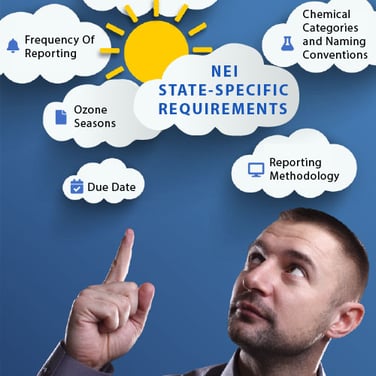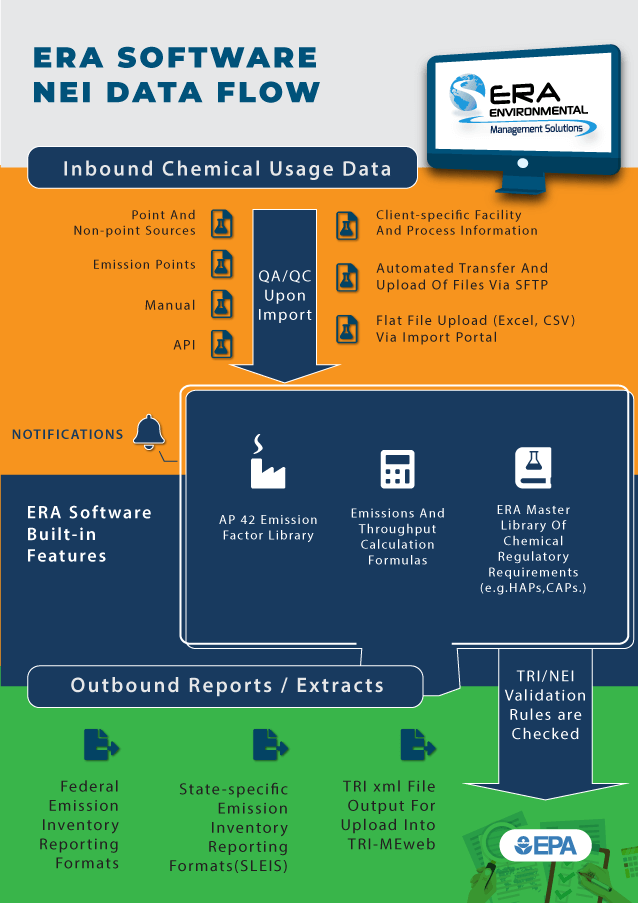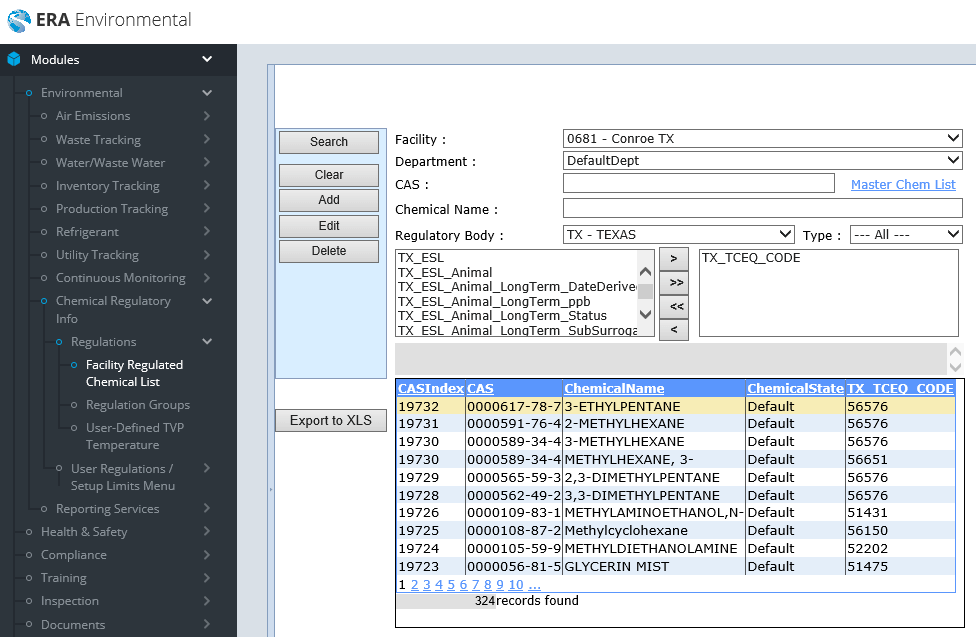NEI reporting is no easy task. Manufacturers and other industries are required to track and report all significant air emissions to their state. The variety of rules associated with each state make it hard for EHS managers to file their reports accurately.
If your company produces any air emissions above certain threshold levels, then your facility may need to report these for the National Emissions Inventory (NEI). This is a requirement of the Air Emissions Reporting Rule (AERR).
In this article, you will learn what NEI reporting is, familiarize yourself with the requirements that apply specifically to individual facilities (as opposed to state agencies), and understand how using a software tool can help you complete this report painlessly.
What is NEI?
The National Emissions Inventory (NEI) is a detailed account of air emissions of criteria pollutants and precursors (CAPs) and Hazardous Air Pollutants (HAPs) from air emission sources. State, Local, and Tribal (SLT) air agencies are required to collect this emissions information from the applicable facilities in their jurisdiction. Depending on the conditions set at the state level, the data may be collected annually or every three years, though it is only published triennially by the EPA. The EPA uses this data to evaluate National Ambient Air Quality Standards (NAAQs), assess the status of interstate transport pollutants, and form proper state implementation plans for controlling emissions, all of which are requirements of the Clean Air Act.
What Facilities are Required to Report to the NEI? What Data do You Have to Submit?
If your facility releases any emissions from CAPs at or above a certain threshold, then you must submit air emissions release data for all sources. The thresholds vary by pollutant and annual potential to emit (PTE); see if your facility meets any of the following:
- A PTE of 2,500 tons per year of sulfur dioxide (SO2), carbon monoxide (CO) or nitrous oxides (NOx), OR
- A PTE of 250 tons per year of volatile organic compounds (VOCs), particulate matter (PM, be it PM10, PM2.5, organic carbon, or black carbon), or ammonia (NH3), OR
- 5 tons per year of actual lead (Pb) emissions.
Meeting either of the first two thresholds means your facility is a Type A point source and must report actual emissions for all the pollutants it releases (even if the other pollutants have PTEs below the threshold) every year. However, smaller facilities that meet the third threshold or have a PTE at or above 100 tons per year of any CAP are considered Type B point sources and must report every three years.
Moreover, certain states have lower thresholds than these. They may prioritize a certain CAP over others, call for data on HAPs (though they are often voluntary), or track emissions that do not correspond to point sources—smaller stationary nonpoint sources, onroad and non-road mobile sources, and ‘event’ sources specific to wildfires and prescribed burns. Check with the SLT agency in your jurisdiction to ensure your facility respects its reportable concentration levels and fulfills the specific requirements for emission sources and submission frequency.
It is due to specificities like these that many facilities are turning to comprehensive environmental software that automatically track day-to-day emissions and generate reports in the format needed for a particular state agency.
Once you have determined the pollutants and categories that apply to your facility, the next step is collecting the data you will eventually input into the Emissions Inventory System (EIS) (where applicable). Start with your facility identifiers, regulatory codes, and permit limits, then gather information on the units in your facility from which pollutants are emitted into the environment, on the specific processes that produce these emissions, and on their respective release points—stacks or fugitive. Make sure to include all control devices and practices that are applied to these units and processes. You will then have the necessary setup to accurately calculate or estimate the sum of air emissions of each pollutant released over the reporting period.
Keeping up with federal and state regulatory updates can be time-consuming and complicated, to say the least. Anything from additions to NEI chemical lists to changes in data entry parameters may alter the procedure you followed last reporting cycle. Unless you store and prepare your data in a software that automatically updates in tandem with environmental regulations and industry classification systems, it is your duty to check your state’s and the EPA’s list of changes and collect your data accordingly. Start early, you do not want to be surprised by non-compliance penalties come reporting season.
State-Specific NEI Reporting Requirements
Because the emissions inventory data are collected by local agencies, the NEI report requirements and format are heavily state-specific, sometimes county-specific.

Below are a few examples of the variables that can differ by state:
- Frequency of reporting: As mentioned above, some states’ reporting thresholds are lower than the EPA-mandated ones, such that a facility that would otherwise be considered Type B and required to report triennially might be classified as Type A and have to report annually.
- Due date: The EPA closes the Facility Inventory window on early January of the calendar year prior to the final NEI’s publication (for 2020, the deadline falls on January 9th, 2022). That said, each state has the right to set its own due date. These often range from February to August of year immediately after the reporting year (i.e. 2021 for the 2020 report).
- Ozone seasons: Beyond setting their due dates, states can require additional reporting for their ozone seasons (the period in which ground-level ozone reaches its highest concentrations). If they do, reporting may become more frequent, particularly in relation to NOx and VOCs emissions that mix to form ozone.
- Chemical categories: Some states ask for speciated HAPs, others only the total HAPs (without speciation), and others make submitting them voluntary.
- Chemical naming conventions: Several states have pollutant codes that differ from the default NEI codes.
- Reporting methodology: It is common for SLT agencies to impose specific requirements on receiving your emissions data for compilation. Some use a streamlined data management software, known as the State and Local Emissions Inventory System (SLEIS), while others are transitioning to the new Combined Air Emissions Reporting (CAER) application. Moreover, there are restrictions on the uploading format; some states prefer Excel or CSV files over JSON files, and vice-versa, and some do not accept uploads from third-party software altogether!
Make sure to verify how often your company should be reporting, especially if you have facilities in multiple states. Thankfully, modern software has evolved to differentiate between the requirements of distinct regulatory bodies. ERA’s NEI Reporting Module generates state-specific output files with report results that you can preview, verify, troubleshoot, and upload directly to state systems (where accepted by the state). Even if your state does not have a submission form, ERA’s environmental reporting tool takes care of your reporting necessities in any number of file formats, allowing you to accurately keep track of your facility’s total emissions.
NEI-TRI Overlap and How it May Impact Your Reporting
Before submitting, it is important to cross-check your NEI data with the air emissions results you plan to send in as part of your TRI Report (Toxic Release Inventory – SARA 313 – Form R). Regulatory auditors will often look over your data to see if it is consistent across these two submissions, as this information is public and available online. They do this because the EPA deems that the programs collect complementary information and have the same fundamental guidance for reporting. As it happens, the TRI covers two of the CAPs (lead and ammonia) and roughly 96% of the 187 HAPs listed under the NEI, as well as several chemical categories with partial overlap. Though the two differ in their terms and requirements, as summarized in the table below, including TRI data in NEI submissions is indeed possible, and a couple of states (Minnesota and Illinois) are already requiring it.
| TRI | NEI | |
| Who reports? | The facility itself | SLT agencies |
| Reporting frequency | Annual | Annual for largest sources; triennially for all sources |
| Data system used | TRI-MEweb | EIS |
| Pollutants covered | TRI-listed chemicals | CAPs (mandatory) and HAPs (voluntary) |
| Exemptions | Employee number exemptions (<10 full-time employees), otherwise use exemptions, de minimis exemption, etc. | Exemptions for facilities on tribal lands and for non-routine emissions (sometimes voluntary) |
| Emission Calculation Codes | 6 codes for basis of estimation | 23 codes that describe different emissions estimation methods |
In fact, the similarities are so prominent that the EPA is looking into a shared air emissions system. Through a series of research projects on potential workflows, among them the Product Design Team’s SLT-NEI-TRI Mapping, it found that roughly 65% of NEI-covered stationary facilities report at least one pollutant also found in the TRI, such that 97% of the TRI emissions that readily match NEI pollutants are loaded into the EIS. In a sense, the release masses for the chemicals on both programs’ lists were being double counted—once when the facility submitted its TRI Form R, and another when it uploaded its NEI data to the EIS.
As a result, the EPA is planning on transitioning to a Common Emissions Form (CEF), which would be a part of the CAER application currently up and running. In it, facility reporters would have access to an interface where they would report their emissions to SLT EIs and the TRI-MEweb system simultaneously. The form would accommodate all state-specific requirements in its design; the only additional step for reporters would be complementing the TRI form with the missing data (i.e. the CAPs and HAPs not included in the NEI, as well as waste from non-air emissions). Overall, it would reduce the reporting burden on facilities and save tens of manual data entry hours.
The EPA is already advising SLT agencies to review their facilities’ TRI emissions estimates as a way of informing their NEI reporting. By the same token, starting this 2020 NEI cycle, it is possible to report all pollutant codes at one time rather than separating the specific pollutants required under each program. Now more than ever, having a centralized, non-siloed environmental compliance system that ensures your NEI and TRI data match is imperative to avoiding non-compliance fees.
How Do You Submit Your NEI Report?
For the time being, however, the two programs have different reporting mechanisms. Whereas you submit your TRI data directly to the EPA through the Central Data Exchange (CDX), your NEI data must go through the EIS of your state’s choosing. The reason for this extra step is that the AERR requires SLT agencies to collect, QA, and review the data, which they do using the EIS Bridge Tool, before the EPA collates it to build the NEI. Accordingly, your facility will have to submit to a SLEIS (accessible by web; see Arkansas’ system for an example) or an entirely different, state-specific system (such as Texas’ STEERS). Most of these work on mdb files, so as long as you measure, monitor, and store your data electronically, submitting your NEI report should consist of a few, easy steps. That said, if you have any doubts about your facility’s situation, contacting your SLT agency is the best place to start.
ERA Software
Having a collaborative EHS platform to track and report your air emissions is an efficient way to seamlessly complete your NEI report. ERA’s NEI reporting software allows you to create new NEI reports, view reports from previous years, and easily upload your complete report to e-reporting tools. It also consolidates relevant NEI data throughout the reporting year, including:
- reporting facility and permit information
- source process IDs
- sources, process equipment, and emission points
- product specifications

ERA’s software makes use of a Master Chemical List (MCL) that compiles over 200,000 chemicals and covers the processing requirements of as many as 20 different federal and state regulations. By simply identifying the regulatory body and category, you have access to an index with all the chemicals your state monitors and their corresponding codes. The MCL is updated annually, following your regulatory body’s publications, such that you are never at risk of forgetting to track, or incorrectly reporting, a specific chemical. Based on this customized setup, your source reporting requirements, and your facility’s data, the software calculates your emissions from all point and non-point sources for you.
The screenshot below provides an overview of how uncomplicated the process becomes when you have built-in regulatory tracking. Notice how selecting the Facility Regulated Chemical List option on the Modules sidebar and, in this example, the Texas Commission on Environmental Quality (TCEQ) Codes is enough to display all the chemicals a Texan SLT agency could possibly ask your facility to track.

Additionally, the platform allows you to analyze your validated results, through QA and XML database analysis, before generating state-specific output files that are fully compatible with EPA’s bridge tool. All you have to do is send the SLT agency in your jurisdiction your finalized report.
ERA’s software streamlines data management and automates your environmental reporting, which in turn drastically cuts your manual data entry hours and lightens the load on your EHS team.
To learn more about ERA’s environmental management software, book a consulting call below.
This Blog was Co-Authored By:



June 23, 2021

Comments